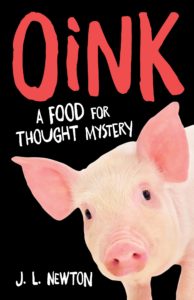By Larry Brooks
There is an article in the latest edition of Writers Digest Magazine about story structure (written by a story coach), built upon this assumption: human beings innately understand storytelling, because we’ve experienced stories all our lives. It’s in our DNA. This is why stories work, why they touch us and teach us and entertain us.
But it doesn’t remotely empower us to write one. That article, however, would have us believe otherwise. To be fair, the article is otherwise valuable and useful, especially the seven questions put forth about a story, the answers to which will pave the to a structure that will work. Trouble is… the article seems to suggest that it is that natural instinct that will empower the reader to know what to do with the answers.
And that’s where it falls apart. Knowing what your character wants and what blocks the path is different than understanding the key principles of story structural that are already there – you don’t have to, nor should you, try to reinvent them every time you write a story – that propell those answers into the story with dramatic effectiveness.
The article and this assumption imply that anyone can, in fact, sit down and write a novel, presumably by tapping into this natural gift, which, like riding a bicycle, is available only to human beings. Never mind that with other natural gifts, some of us end up being better athletes or musicians or professors… with storytelling, it seems, we’re all in the same creative boat.
To which I say… what is more true is that we all have equal access to learning the principles that could result in you writing a crack story worthy of publication and readership. My hypothesis here, my counter argument, is that unless you engage in a dance with those principles—which are deep and wide and clearly evident in the books you read—you are nowhere near knowing what you need to know to make your story work, at least without spending years trying to get there.
And you can get there, draft after draft, feedback upon feedback, year after year. But even then, your ability to comprehend and implement the feedback that will facilitate how your story needs to change—or simply realize what needs to change on your own, which certainly can and does happen—depends on your understanding of those very same principles.
This is no different than your family doctor of forty years knowing more about medicine than your nephew who just entered med school. Natural DNA gifts aren’t part of the equation.
If you’ve tried this “just write” DNA approach to writing a novel, you may already have formed an opinion about the natural state of the ability of human beings to write publishable stories, versus the accepted principles of storytelling that professionals end up abiding by, almost every time. Perhaps, upon realizing how challenging this is, that you didn’t win the DNA lottery after all. It’s why so many of us have a novel we started and couldn’t finish, or a drawer full of manuscripts that nobody wanted, and perhaps we now understand why.
Or not.
Look Ma, no hands! I’m a natural!
The WD article contends that, using our innately informed sense of story, we are all equipped to sit down and write a story that is within revision-distance—which is a little like shouting distance, only further, like yelling a message from Miami to Houston—from being able to take what you’ve assembled from the first pass and actually suddenly, tapping into that secret DNA, know enough to credibly fix it.
Analogy: you open a jigsaw puzzle without studying the image on the cover, you pour it out on the floor… and then you fix it. But you have to look at the picture to do that within a reasonable lifetime.
Another analogy for those who don’t do jigsaw puzzles, or don’t agree than a novel is at that level of complexity: Imagine you are on an airplane. Suddenly an announcement comes over the PA asking if anyone knows how to fly, because the pilots are inexplicably unconscious. So, because you’ve flown so many times—equivalent to having read a lot of novels in this analogy—and you are the hero of this story, you volunteer to head up to the cockpit, pausing only to throw up in the unoccupied mile-high bathroom next to the cockpit door.
What the heck, you rationalize… if it doesn’t work, I’ll just fix it later.
I’ll just fly.
There is no shortage of writers who adopt this approach toward the writing of a novel. They’ve read hundreds if not thousands of them, so they believe they possess the natural sense of story required to get it right. They regard craft with a grain of alcohol, betting that they can get there from the seat of their pants.
Meanwhile, the clock keeps ticking away.
There are actually three assumptions at work here.
First, that there actually are expectations and standards and forms and functions within the craft of storytelling, principles that published novels abide by. Principles that all such books demonstrate, once you know what to look for. A published author can explain, for example, why The Girl On The Train works (discussing setup and foreshadowing and subtext and structure and emotional resonance and narrative arc and thematic weight… all the stuff that article contends we innately already grasp), and do so in writerly technical terms.
Readers, however, explain it in a way that only skims that surface: It held my interest. I felt for the girl. I wanted to see how it turned out. I couldn’t’ get it out of my head.
The reader experiences… but the writer knows.
There actually are things we need to know and understand… a deep well of knowledge, in fact, before we can reasonably expect to drive the literary bus. The good news is that it is learnable and accessible, and when you do finally wrap your head around it, you’ll see it bursting from between the covers of every novel you read and film you watch.
Second, that we do indeed—all of us, endowed equally—possess such an innate understand.
Pigs are flying everywhere in the light of this assumption.
Let’s agree that our high school freshman offspring is not yet able to do this, so we can therefore assume that somewhere between the appearance of pubic hair and finishing one’s first pass at Lord of the Rings, the ability to naturally craft stories manifests in our brain cells.
And third… other is that the same sense that results in the brain-drain draft that is part of the initial assumption, is equipped to then fix it through revision. As if this supposedly natural gift, the one that we all possess, can think “oh, that’s what I should have done the first time,” and move toward publishability from there.
Tick tock.
The article then goes on to suggest…
… that anything beyond a learned modeling of story (from the same reading experience that fed the story DNA, I suppose) is reduced to mere formula. Which is assumptively regarded—disregarded, actually—as a bad thing indeed.
Tell that to the halls full of successful romance and mystery authors who are on their twentieth title. Tell them that what they do is formula—because nobody will argue, the linear contextual unfolding of genres in those and other stories is nearly identical in every book—and that it is a bad thing.
It’s not formula. It’s form. Narrative flow. Context. Story arc. Dramatic theory.
We are pressured to abide by the truism that there are no rules in storytelling.
All the Big Names tell us this.
But, ask around. Ask those halls full of successful authors. Ask the crew here at Killzone. “Rules” is just a word. What is present within the storytelling proposition is the looming, story-saving imposition of principles, including those that relate to story structure, that are the very thing that become the benchmarks, criteria and targets for which we strive—and must reach—as professional storytellers working genre fiction.
All successful writers use them, even if they don’t have names or labels for them, even if they claim to have summoned the story forth from the depth of their gifted genius.
On top of the basic principles, there are specific principles that create expectations within the various genres. The author doesn’t tell us that we are born with those, too… that Nora Roberts was a born romance author, but not so much when it comes to… wait, she is a killer mystery writers, too, and I bet she could know a time travel story out the part, too.
Because of what she knows.
Literary fiction… there are principles there, too. A bunch of them, in fact, just like us. It actually gets more airtime out there, which becomes a sort of toxin in the learning experience of new authors, who buy into the notion that it is all about the hero, and the other characters. But that’s a loaded statement… not wrong, per se, but in genre not yet right enough. In genre fiction, it’s all about the dramatic arc, fueled by something conceptual, that becomes a window through which we manifest and observe characters and their story arc.
Where in the DNA mind-map does that little subtlety show up?
No, that is something we must learn.
Without a plot fueling our genres (thrillers, mysteries, romances, fantasy, science fiction, and all the mashups you can think of) that is infused with a hero’s problem/quest/journey, in the face of something antagonistic that seeks to block their path (or kill them), and with significant, emotionally-resonant stakes motivating everyone on both sides… without all that, we are left with the biography and episodic adventures of a fictional character, with little to root for.
Without rooting, all that’s left is observing. And outside of literary fiction, that doesn’t work.
We must learn that, as well.
It’s like the difference between staring at and analyzing a still photo, versus being swept away by a motion picture driven by those same story elements and essences.
So no… we’re not born with that sensibility. I’ve worked with hundreds of new writers, really smart people with big brains and big ideas, who didn’t have a clue. Who write 200 pages of setup in in 380-page manuscript. That write “the adventures of” their own life, or a span of it, that amount to nothing more than a diary, without the slightest connection to a dramatic spine or the posing of a dramatic question.
Did you know, when you started, deep in your gut, in your DNA, the same storytelling DNA that the WD article claims will take you the promised land… that a story unfolds in a series of differing contexts which are non-negotiable (labeled as parts or acts), one bleeding into the next, and that there are optimal places for the insertion of escalation and twists? That these things aren’t random, but rather, the very thing that one cleans up—moves toward—when the story isn’t working, when it was poured from the box of your brain onto the floor of your manuscript to become a pile of disconnected notions and intentions?
You didn’t know that upon finishing your first read of Lord of the Rings. You had to learn it. If not through craft, then through assimilated experience that never saw a shred of that magic DNA.
You must learn this stuff.
Sometimes over years of experience and feedback. Sometimes—often both—with the eventual embrace of story modeling that impart all this craft into the same brain cells, in the right way and right order, that this article author claims you possess naturally?
What we’re talking about here is story sense. That author claims you have it already, that you only have to ask yourself the right questions (seven of them, included in the article) to tap into it and empower your ability to navigate the narrative path that will ultimately make the story work.
But consider this: all of the craft out there that awaits you, on this site and others, in books like my three writing titles and training videos, and those of Jim Bell and Robert McKee and Michael Hague and Art Holcomb and a bus full of other so-called writing gurus… all of it has one purpose, and one purpose only: to ignite and empower your sense of story.
To render you capable of the just write approach.
Once fully ablaze with a full awareness of the principles of craft, then you actually can take your story idea to your keyboard and just write. Because with those principles grinding and vetting and molding the narrative before it reaches your fingertips, the story will appear in your first and early draft in a vastly elevated form… something you actually can fix using those same awarenesses.
Some clarification is in order here.
Our friend and my colleague here on Kill Zone, Jim Bell, has a new book out entitled Just Write. It’s terrific, robust and empowering. But don’t be fooled by the title (just as you should not be fooled by the title of another book by another guru, “Story Trumps Structure,” which it absolutely does not), Jim is not remotely suggesting that as your first line of attack on a story you should just write, nor is he saying you’ll be fine because of that secret storytelling gene that will unlock the story upon command.
Rather, he’s saying pretty much what I’ve said here. Jim and I occupy the same space on the writing shelf at your local Barnes & Noble. We are craft guys. We preach it, teach it, model it, deliver it as best we can. What I believe Jim is saying in his book is this: armed with some awareness of the principles of storytelling, and fueled by a vibrant idea that this awareness allows you to vet, then one of your options in the continuing process of discovering and developing your story is, in fact, to just write.
Another option—because it leverages the same body of awareness—is to just outline. Just line your walls with yellow sticky notes. Just compose as much of the narrative shape of a story in your head before you sit down to a draft.
All of these processes are viable. Because they are all equally dependent upon an understanding of story. To “just write” without that awareness is to step into the forest without a map, an umbrella, or a stun gun, or even without shoes. Many writers use drafts as their vehicle of story discovery, years and years of them—this being another, very different context of “just write”—versus a separate track of more principle-based training, or at least a concurrent focus (which gives you two avenues of evolution as a writer, versus either one alone).
It’s all story discovery and development.
It’s all process.
And while the principles will put you in a specific lane defined by specific story criteria—this is a certainty; if you deny it or fight it off, ask yourself if you can find a published commercial genre story that doesn’t abide by the principles of craft… you actually can’t, any more than you can find a bird or an airplane without wings—you will actually be more empowered to trust your gut as you… because now your gut is in a different league of capability.
Versus, say, the writer who doesn’t know a setup quartile inciting incident from a midpoint context shift.
The physics of stories is no more flexible or forgiven than, well, the physics of gravity. We can harness gravity, we can manage it to fly and dance and play, we can optimize it for specific purposes, but without wings that harness that power, we end up on the floor, right next to that pile of story that you tried before you knew.
It’s time you learned how to play this game, regardless of the state of your natural literary genius.
Tick tock.
*****
Are you interested in learning more about craft, framed in a fresh and empowering way?
Over the break I’ve launched a series of hardcore craft training videos for writers, called The Storyfix Virtual Classroom. At this writing there are FIVE topic focuses (one of them on structure), from 61 to 118 minutes in length. These include a classroom-style lecture, with “live” talking head and PowerPoint data points, all instructionally-designed and optimized.
Go to www.vimeo.com/ondemand/storyfix to check them out. Or to read more, go to my new training website at www.storyfix-training.com.
Here’s a 25% discount for Killzone readers: use this code – Killzone25off –during checkout to receive this deal.









